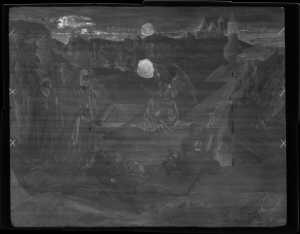After the burial of Christ, three women go to his grave to anoit the body. When they arrive at the tomb, they see that the stone has been rolled away and an angel tells them that Christ has risen.This moment is described in all four gospels and the Van Eyck brothers have depicted it on this large panel. The soldiers who were standing guard at the grave are still sunk in deep sleep.
Mary Magdalene, in her red dress, is kneeling. She is looking at the angel seated on the stone that had sealed the tomb and at the same time pointing at the empty tomb.The angel is making a gesture of greeting. Who the otther two women are is not hundred percent clear. The Mary in the blue gown could be the mother of Christ, but in the gospel of John she is called Mary Cleophas. The third woman is Mary Salome. A medieval city is shown in the background. It is a reasonably faithful representation of Jerusalem in the 15th century. This large panel is the only work by the Van Eyck brothers in the Netherlands.

Specifications
| Title | The Three Marys at the Tomb |
|---|---|
| Material and technique | Oil on panel |
| Object type |
Painting
> Painting
> Two-dimensional object
> Art object
|
| Location | This object is in storage |
| Dimensions |
Width 90 cm Height 71,5 cm |
|---|---|
| Artists |
Attributed to:
Jan van Eyck
|
| Accession number | 2449 (OK) |
| Credits | Acquired with the collection of D.G. Van Beuningen, 1958. The restoration of this painting in 2012 was made possible by Nedspice |
| Department | Old Masters |
| Acquisition date | 1958 |
| Creation date | in 1425 - 1435 |
| Collector | Collector / D.G. van Beuningen |
| Internal exhibitions |
Van Eyck tot Bruegel (1994) De weg naar Van Eyck / The Road to Van Eyck (2012) De collectie als tijdmachine (2017) Lievelingen (2024) |
| External exhibitions |
Nederlandsche Kunst van de XVde en XVIde eeuw (1945) Boijmans bij de Buren - REMIX ROTTERDAM, Boijmans X Wereldmuseum (2020) Van Eyck. Een optische revolutie (2020) |
| Research |
Show research Alma |
| Material | |
| Object | |
| Geographical origin | Southern Netherlands > The Netherlands > Western Europe > Europe |
Do you have corrections or additional information about this work? Please, send us a message
All about the artist
Jan van Eyck
Maaseik circa 1390/1399 - Brugge 1441
Jan van Eyck worked at various royal courts, and was, for example, court painter to Philip the Good of Burgundy. It is suggested that Jan van Eyck discovered...
Bekijk het volledige profiel
























